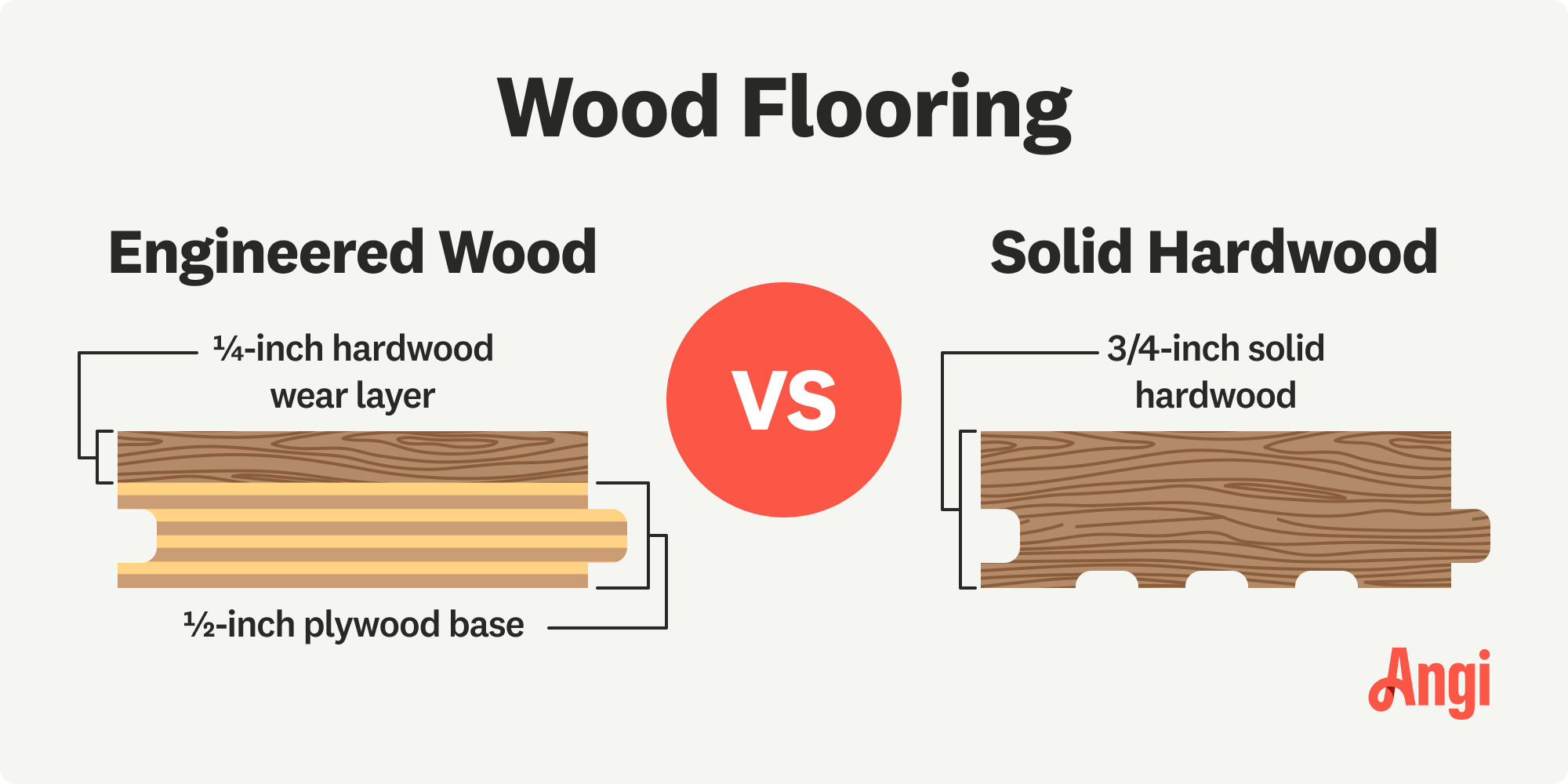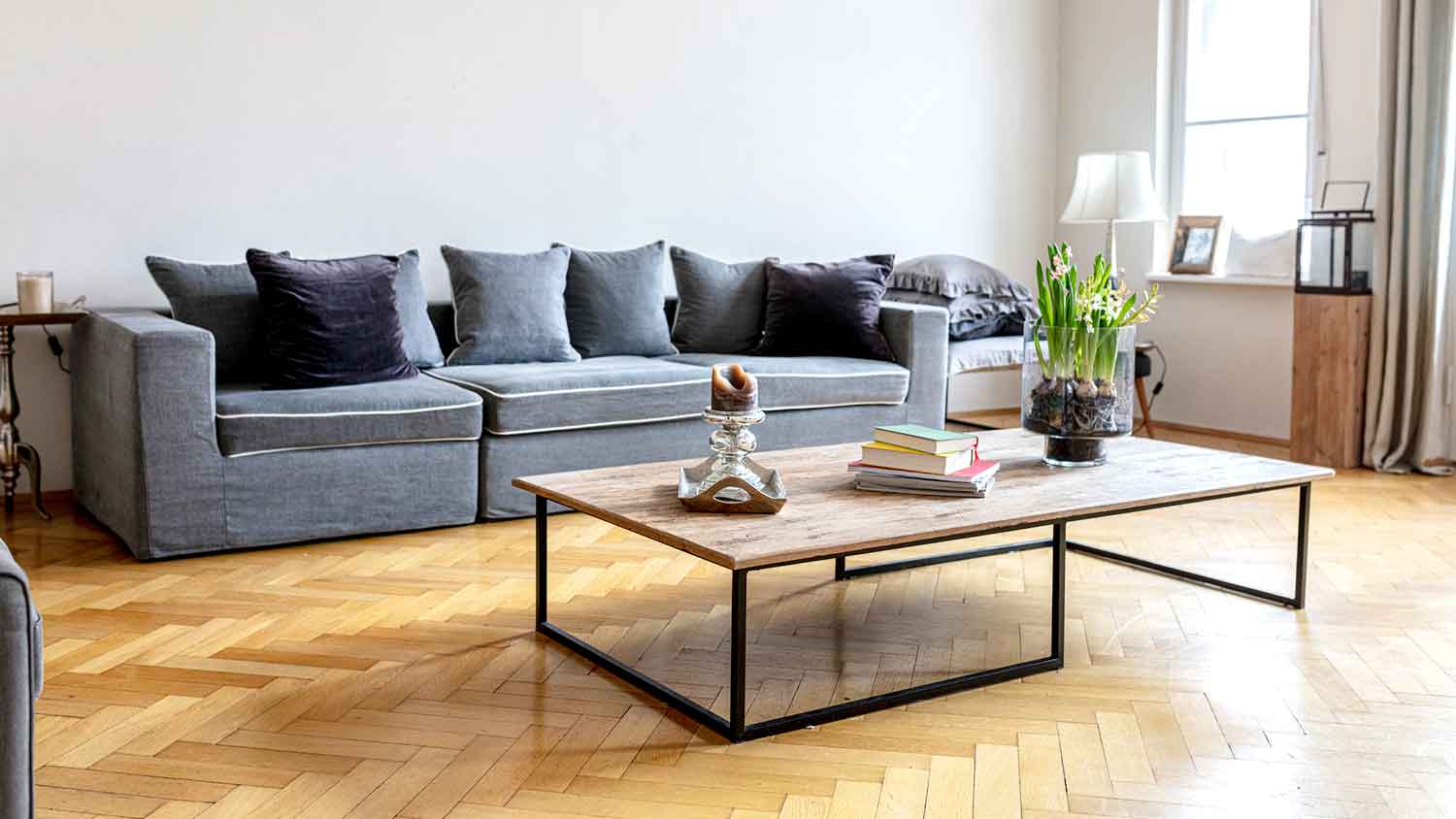
Both materials and labor determine hardwood floor installation costs. This guide breaks down all the prices you need to know before starting your new flooring project.
Hardwood or hardly worth it?


Engineered wood flooring is easier and less expensive to install.
Solid hardwood flooring lasts longer—100 years or more—and you can refinish it.
Choose engineered wood for entryways and kitchens, since it’s more moisture-resistant.
Solid hardwood has a higher ROI and higher resale value.
Both types of flooring provide beautiful, natural wood finishes for an upscale look.
Choosing new flooring is one of the most exciting (and overwhelming) parts of home renovation. You want something beautiful, durable, and worthy of your investment. Two of the most popular options—engineered wood flooring and hardwood flooring—offer the elegance of real wood, but they come with different perks. Let’s compare the two head-to-head so you can make an informed choice.
At first glance, engineered wood flooring and solid hardwood flooring look nearly identical. The difference lies in the construction: solid hardwood is a single piece of natural wood, while engineered wood has a thin hardwood veneer over a plywood base. This makes engineered flooring more affordable and moisture resistant, but it doesn’t last as long as solid hardwood. A professional wood floor installer near you can make recommendations for the best flooring for your home and install it properly.


Engineered wood flooring features a top layer of real hardwood over a sturdy core of plywood or high-density fiberboard. The layered construction adds stability and reduces the chances of warping.
| Pros | Cons |
|---|---|
| More affordable than solid hardwood | Limited refinishing options |
| Handles moisture and humidity better | May sound hollow underfoot |
| Easier DIY installation | Can’t be sanded as many times |
| Available in wider plank sizes | Less eco-friendly due to adhesives |
Best for:
DIY projects
Rooms with moderate humidity
Budget-conscious homeowners
Spaces without heavy wear and tear
Engineered wood flooring is a great choice for homeowners who want the look of real hardwood without the higher price tag. Because it has a hardwood veneer over a plywood core, it consists of less hardwood per plank, bringing costs down. You can find engineered wood in wider planks and with unique finishes that are harder to find in solid wood. It is also possible to spend less on the cost of installing engineered flooring than on hardwood flooring.
Another major plus is that engineered wood stands up better to humidity and moisture. The layered construction resists warping and shrinking, making it a smarter choice for kitchens, basements, and bathrooms. It’s also easier to install and DIY than solid hardwood, especially if you choose a floating or click-lock system.
Despite its perks, engineered wood flooring has limitations. One of the biggest drawbacks is its relatively short lifespan. While you can refinish some high-quality versions once or twice, most engineered wood floors can’t handle repeated sanding like hardwood can. Once the top hardwood layer is worn through, you have to replace it.
It also may not feel the same underfoot. Floating engineered floors can sound hollow or less solid than hardwood. And while planks are made with less wood, they’re made with adhesives and resins that may release VOCs (volatile organic compounds), which can be a concern for eco-conscious homeowners.

Hardwood flooring is made from solid planks of natural wood, including oak, maple, walnut, and cherry. Each board is milled from a single piece of wood, making it strong, stable, and long-lasting. You can buy it unfinished or prefinished for easier installation. There are different grades of hardwood flooring, though, so you’ll need to choose the type that fits your preferred look and budget.
| Pros | Cons |
|---|---|
| Can last 100 years or more | More expensive than engineered wood |
| Can be sanded and refinished many times | Susceptible to moisture damage |
| Better sound absorption | More difficult to DIY |
| Wide range of wood species and stains | Narrower plank widths unless custom |
Best for:
Historic homes and traditional aesthetics
High-traffic areas like hallways and living rooms
Buyers seeking top resale value
Rooms where moisture isn’t a concern
The biggest advantage of solid hardwood is longevity. With the right care, it can last 50 to 100 years or more. Unlike engineered flooring, you can sand down and refinish solid hardwood multiple times—making it possible to repair deep scratches and stains or change up the look. That flexibility gives it a longer usable life and makes it a favorite of homebuyers.
Solid hardwood also provides a luxurious underfoot experience. It feels dense and sturdy, and it absorbs sound better than floating floors. It also comes in various species, finishes, and board widths, so it’s easy to find an option that suits your space, especially if you’re going for a high-end, classic aesthetic.
With all its advantages, it’s no surprise that hardwood flooring comes at a price. It’s more expensive than engineered wood, both in materials and labor. Most installations require specialized tools and expertise, which makes DIY projects difficult for beginners. If you’re planning to install new flooring over concrete or in moisture-prone rooms, solid hardwood isn’t the best fit.
Hardwood or other solid wood floors are not good candidates for wet areas of a home. Liquids can soak into natural wood floors and cause finishes to discolor or fail, particularly at the joints between the boards or near the ends of the boards next to the baseboards.
Moisture isn’t good for hardwood floors. Too much humidity or an unexpected leak can cause boards to warp, cup, or split. That means it isn’t a good option for bathrooms and below-grade spaces unless you’re prepared to take extra precautions with subflooring and climate control.
Let’s put these popular flooring options head-to-head and see which comes out on top in the categories that matter most.
Both engineered and solid hardwood offer a stunning, natural wood look. Solid hardwood have tighter seams and a more traditional aesthetic, while engineered wood offers a broader selection of trendy finishes and wider planks. Ultimately, this comes down to a matter of taste.
Thanks to its layered construction, engineered wood supports a wider range of wood species, including softer or exotic types that aren’t ideal for solid hardwood flooring. Plus, it comes prefinished in modern styles, colors, and textures, which means you can save time during finishing.
Solid hardwood stands up better to wear over time. You can sand and refinish it repeatedly, giving it a fresh start if it gets scratched or dented, or when you want a new color. Engineered wood’s thin veneer means you can only refinish it a limited number of times—if at all.
When comparing the cost of installing different flooring, engineered wood is more affordable. It ranges from $4.50 to $16 per square foot, while solid hardwood ranges from $6 to $25 per square foot, depending on the species and grade.
Engineered wood is designed for easy installation. Click-lock, glue-down, and floating options make it DIY friendly. Solid hardwood, on the other hand, requires nailing and precise tools for cutting, sanding, and finishing, so it’s a project that’s best left to the pros.
If your hardwood flooring is scratched, dented, or stained, you can sand it down and start fresh. In comparison, engineered wood will need replacement once it’s damaged beyond its veneer layer.
Both types of flooring are relatively low-maintenance. Regular sweeping, vacuuming, and the occasional damp mop will keep them looking good. Just skip the steam cleaner and use products specifically designed for wood floors. You can also polish your hardwood floors to add extra protection and make them shine.
Engineered floors last 20 to 30 years on average, while solid hardwood can remain in great shape for generations with good maintenance and periodic refinishing.
Engineered wood consists of fewer raw trees per plank and manufacturers can use recycled wood or waste wood for its plywood layers, but it can include chemical adhesives that aren’t biodegradable. Producing solid hardwood flooring requires more trees, but it’s fully natural, recyclable, and biodegradable at the end of its useful life.
Solid hardwood consistently ranks as one of the most desirable flooring types. Its long life, classic appeal, and ability to be restored help it edge out engineered wood in resale value. According to the National Association of Realtors®, you can expect an ROI of 118% for the cost of new hardwood floors and up to 147% for refinishing hardwood floors when you sell your home.
From average costs to expert advice, get all the answers you need to get your job done.

Both materials and labor determine hardwood floor installation costs. This guide breaks down all the prices you need to know before starting your new flooring project.

Hardwood floor repair costs depend on the problem. This guide breaks down common costs based on factors like the type of problem, repair method, and whether you hire a pro or DIY.

It’s impossible to keep floors damage-free over the years. Thankfully, the cost to refinish hardwood floors is far less than the price tag to replace them altogether.

Hardwood floors improve the look and feel of your home. Refinishing them requires some work, but with these tips, your results will be better.

Learning how to finish unfinished hardwood floors is a big project, but it is one that experienced DIYers can take on. Use this guide to find out how to get it done.

Engineered hardwood vs. LVP flooring: Which is best for your home? We break down the pros and cons to help you make the best choice.